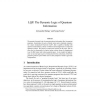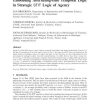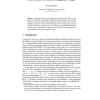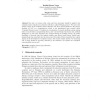88
Voted
APAL
2005
15 years 14 days ago
2005
A new semantics is presented for the logic of proofs (LP), [1, 2], based on the intuition that it is a logic of explicit knowledge. This semantics is used to give new proofs of se...
110
Voted
AML
2005
15 years 14 days ago
2005
IMTL logic was introduced in [12] as a generalization of the infinitely-valued logic of Lukasiewicz, and in [11] it was proved to be the logic of left-continuous t-norms with an i...
101
Voted
SLOGICA
2008
15 years 14 days ago
2008
A generic format for adaptive vague logics is presented. The concrete adaptive vague logics based on this format are able to (1) identify sentences as vague or non-vague in the con...
92
Voted
SLOGICA
2008
15 years 14 days ago
2008
Logic is a celebrated representation language because of its formal generality. But there are two senses in which a logic may be considered general, one that concerns a technical a...
131
click to vote
MSCS
2006
15 years 15 days ago
2006
We present a dynamic logic for reasoning about information flow in quantum programs. In particular, we give a finitary syntax and a relational semantics for a Logic of Quantum Pro...
144
click to vote
FUIN
2007
15 years 15 days ago
2007
Mazurkiewicz traces form a model for concurrency. Temporal logic st-order logic are important tools in order to deal with the abstract behavior of such systems. Since typical prop...
99
Voted
LOGCOM
2006
15 years 15 days ago
2006
Seeing To It That (STIT) logic is a logic of agency, proposed in the 1990s in the domain of philosophy of action. It is the logic of constructions of the form `agent a sees to it ...
71
Voted
LOGCOM
2006
15 years 15 days ago
2006
Comparative logics were introduced by Casari in the 1980s to treat aspects of comparative reasoning occurring in natural language. In this paper Gentzen systems are defined for the...
77
Voted
LOGCOM
2006
15 years 15 days ago
2006
An intuitionistic, hybrid modal logic suitable for reasoning about distribution of resources was introduced in [14, 15]. The modalities of the logic allow us to validate propertie...
116
Voted
JUCS
2006
15 years 15 days ago
2006
: Our aim is to discuss what, when and, how deep logic should be taught in the computer science education in connection with the so called "Bologna process". We survey th...




